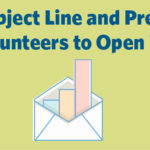Craft a Subject Line and Preheader Pair to Inspire More Opens

How do you keep people reading your email?
By making sure the first thing someone sees in their inbox is your email, and influencing a reader’s decision to open it, not just ignore it along with the other emails.
If your goal is to convince volunteers to sign up for your next event, the first step to directing them to your sign up page is to get your audience to recognize your email in their inbox.
After readers recognize who the email is from, they’re going to turn to the next powerful pair: the subject line and preheader.
New to Constant Contact? Sign up for a free trial today.
Help readers recognize your emails
Before a reader sees your subject line and preheader, the first thing that will catch their eye is your header information, which tells them who sent the email and sometimes also your Reply To email address. Sending consistently will help your audience anticipate receiving an email from you, and will help them recognize your organization’s From Name and email address.
For most nonprofits, the From Name will be the name of your organization. Your From Email should use your website’s domain, such as @heartsandtails.org rather than a gmail account. Also, make sure your Reply To email address is monitored so you can capitalize on any opportunity to connect with people who are willing to help.
Subject Line: What are you talking about?
A strong subject line should capture the attention of your reader, but it should also help set up your email. Instead of trying to summarize your solution, your subject line should highlight the problem you’re trying to solve.
While your subject line can entertain, warn or inform your readers, using a question as your subject line makes the reader need to open your email, such as, ‘Want to feel better about the world?’ Readers will be compelled to open your email to find out the answer to the question posed in your subject line.
Preheader: Add more context, but not an answer
After your subject line presents an issue, use the preheader to show that the problem will be solved with their help, but withhold the complete answer. Instead, show that you’re working on the solution.
The right preheader text can add context without taking away any of the suspense so readers still feel compelled to open your email.
If your nonprofit is helping to feed the hungry in your local community, and have setup a question in the subject line, your preheader can add more context to the problem without spoiling the answer. For example, your preheader could read, ‘You might be the volunteer these kids need.’
Remind your reader why they opened the email
The best way to push readers to sign up as a volunteer for your next event after reading your email, is to deliver on your promise. When someone reads a subject line and preheader combination, then decides to open an email, there is a risk of being disappointed.
When your subject line presents a problem, the body of your email should explain the solution, but also why more volunteers are needed. Make them the hero of your email to boost their engagement, and show them how they fit into the overall solution. Your audience will then be more likely to click on a call-to-action, since it is speaking directly to them.
Start strong to keep your audience reading emails
If your nonprofit organization’s name is familiar to your audience, you’re more likely to catch their eye each time you send an email. Once they start reading, your header, subject line, and preheader all work together to convince them to open it and keep reading. The right words might be all you need to convince volunteers to sign up for your next event.
New to Constant Contact? Sign up for a free trial today.
The post Craft a Subject Line and Preheader Pair to Inspire More Opens appeared first on Constant Contact Blogs.
Contributers : Constant Contact Blogs https://ift.tt/2LHR7vz

















No comments:
Post a Comment